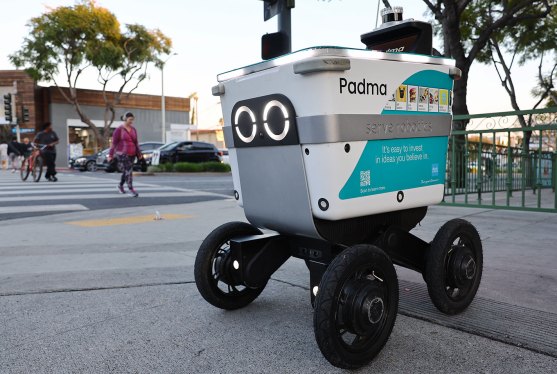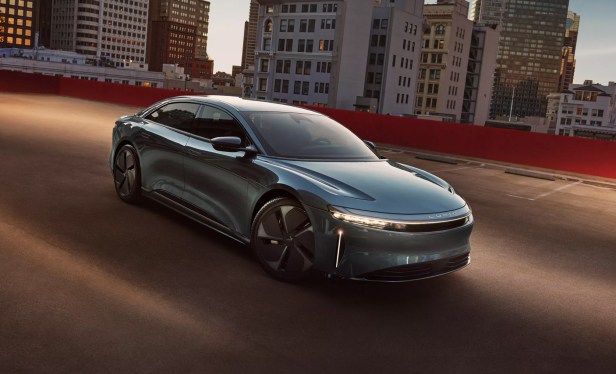The COVID-19 pandemic didn’t just upend the transportation industry. It laid bare its weaknesses, and conversely, uncovered potential opportunities.
Electric bikes sales spiked as public transit ridership evaporated. The public, and investors, began to recognize the utility of autonomous sidewalk delivery bots, which had once been viewed as mere novelties; the rising popularity of on-demand delivery prompted major retailers like Walmart to put more resources toward meeting consumers’ needs and was one of the driving forces behind Uber’s decision to dump nearly every business unit and acquire Postmates.
The upshot? The transformation isn’t over. Following up on our May of 2020 survey of the sector and about the impact of COVID-19 in particular, TechCrunch spoke with 10 investors about the state of mobility, which trends they’re most excited about and what they’re looking for in their next investments. They see opportunities within software, particularly around mobility-as-a-service ventures and fleet management, continued demand for delivery and the push for electrification and batteries as well as the financial instrument — SPACs — that so many startups turned to in 2020. But there’s a lot more; they even see tailwinds for eVTOLs.
Here’s who we interviewed:
- Clara Brenner, co-founder and managing partner, Urban Innovation Fund
- Shawn Carolan, partner, Menlo Ventures
- Dave Clark, partner, Expa
- Abhijit Ganguly, senior manager, Goodyear Ventures
- Rachel Holt, co-founder and general partner, Construct Capital
- David Lawee, founder and general partner, CapitalG
- Sasha Ostojic, operating partner, Playground Global
- Sebastian Peck, managing director, InMotion Ventures
- Natalia Quintero and Rachel Haot, Transit Innovation Partnership/Transit Tech Lab
Clara Brenner, co-founder and managing partner, Urban Innovation Fund
COVID-19 disrupted virtually every sector of the transportation industry. E-bike demand spiked, shared scooters initially struggled with some rebounding, ridership dwindled in ride-hailing and plummeted in public transit as consumers turned to cars and other alternatives. Meanwhile, demand for delivery skyrocketed and the autonomous vehicle industry went through a consolidation. What sectors will recover in 2021 and where are the new and unlikely opportunities to invest?
COVID has exposed how rickety, insolvent and inequitable transit is in the U.S. Tools that empower cities to get compensated for private enterprise monetizing public infrastructure, and that ensure more equitable mobility access are exciting to me. Companies like Ride Report that help cities wrap their arms around all of the various public and private transit happening on their streets are exciting to me.
What are the remaining opportunities for new startups, now that the autonomous vehicle industry is maturing with unprecedented consolidation, billion-dollar funding rounds and even a few low-volume commercial operations kicking off?
Autonomous vehicles still have a long way to go, and there is still lots of room for new startups to make their mark on this space. In particular, we’ve been interested to see new entrants working on software tools to facilitate regulation and parking.
What are the overlooked areas that you want to invest in, now that legacy automakers are shifting their portfolios to electric and new EV manufacturers are preparing to start production?
We are very interested in the emerging fleet management space — and this is reflected in a number of our recent investments, including Electriphi (software to help fleets transition to electric) and Kyte (activating underutilized fleets to deliver a magical car rental experience). There are so many efficiencies that come from the fleet model for transportation — we think this will be an increasingly important area in the coming years.
What is the fundraising model of success for transportation startups of the future? Do you expect early-stage funding in this sector to stay hot indefinitely? Do you see SPACs as the path to liquidity long term for a large number of startups in this sector?
Transportation is important to basically all people and is a real mess, so it will likely continue to be a hot topic and a source of investor interest for years to come. However, for capital intensive transportation companies, the rounds have gotten so huge and expensive that they often make little sense for early-stage funders to participate in (they get diluted down hugely). Not that this seems to be dissuading many investors at the moment.
At the Urban Innovation Fund, we are spending a lot of time looking at software tools that enable larger hardware systems to work more efficiently. In terms of longer-term liquidity, SPACs represent a good option for many companies. That said, consolidation/mergers seems the most logical outcome for most companies in the transportation space — where strategic partnerships and integrations represent critical competitive advantages.
What do you want to see from the Biden administration to accelerate innovation in the transportation sector?
I’d like to see the Biden administration invest in our urban public transit systems — we know those systems can work beautifully. This may not accelerate “innovation,” but it will accelerate progress. This is a fundamental confusion in the VC space — innovation does not always equal progress.
Shawn Carolan, partner, Menlo Ventures
COVID-19 disrupted virtually every sector of the transportation industry. E-bike demand spiked, shared scooters initially struggled with some rebounding, ridership dwindled in ride-hailing and plummeted in public transit as consumers turned to cars and other alternatives. Meanwhile, demand for delivery skyrocketed, and the autonomous vehicle industry went through consolidation. What sectors will recover in 2021, and where are the new and unlikely opportunities to invest?
Pretty much all aspects of transportation will show recovery in 2021 with the population’s strong desire to get closer to normal, daily infections dropping, better mask compliance and increased vaccinations. The slowest will be commute-to-work use cases where the “new normal” for many will be 50%-100% fewer trips to the office on a monthly basis.
Personal above shared movement: The psychological aftermath of the pandemic will persist for some time; people do and will continue to prefer more distance from others. This will lead to an acceleration of personal e-mobility solutions, both outright purchase and subscription models, including scooters and e-bikes (Unagi, where we are investors), asset-sharing models where riders aren’t in close proximity to strangers (GetAround, Turo, Lime, Bird), and single-ridership Ubers and Lyfts over UberPools and the like.
E-commerce supply chain: E-commerce has experienced a step-function in demand that will persist. Many shippers, trucking companies, manufacturers, distributors, etc., are still poorly connected, inefficient, and managed with paper and manual labor. The entire supply chain is ripe for Amazon-like efficiency and clarity; this will be driven by factory/warehouse level automation, robotics, best-of-breed fulfillment, and logistics software like our investments in Alloy, Fox Robotics and ShipBob.
Local delivery: Instacart, DoorDash, UberEats, etc. have brought local delivery mainstream. This trend will continue, and the larger incumbents will be working hard to get their act together for streamlining fulfillment rather than let the delivery fleets capture all of the upsides. Here companies like AnyCart that streamline ordering for grocery and recipes can partner versus compete with large grocery chains to deliver a compelling user experience and more reasonable prices.
What are the remaining opportunities for new startups, now that the autonomous vehicle industry is maturing with unprecedented consolidation, billion-dollar funding rounds and even a few low-volume commercial operations kicking off?
Until there is a teleporter, opportunities will always exist to make transportation better, faster and cheaper for a given distance. The big levers coming are:
Electric propulsion (on ground and air) yields a much lower cost per mile with lower opex motors and lower cost of recharge versus burning fuel. Opportunities exist here mostly for component companies making better batteries, motors and quiet propellers.
Better asset utilization: More efficient routing of vehicles (via routing software), higher capacity utilization (via more efficient marketplaces), and less downtime (through better scheduling and optimization algorithms) bring prices down.
Autonomy: Drivers are a big part of both the cost structure of transportation and also accidents. Human-level autonomy is still several years off, but we see lots of opportunity for autonomy in constrained environments (vehicles moving in repetitive patterns with few obstacles) and through the air.
What are the overlooked areas that you want to invest in? Now that legacy automakers are shifting their portfolios to electric, and new EV manufacturers are preparing to start production, what are the overlooked areas that you want to invest in?
We believe there are many transportation options beyond the car. Electric scooters, bikes, eVTOLs and others will keep growing in popularity for both utility and fun.
What is the fundraising model of success for transportation startups of the future? Do you expect early-stage funding in this sector to stay hot indefinitely? Do you see SPACs as the path to liquidity long term for a large number of startups in this sector?
Transportation will be a perennial sector of opportunity given how large a piece of consumer spend it occupies. Till the late 2000s, Silicon Valley barely touched transportation; this has, of course, changed dramatically since that period, particularly with the rise of Tesla.
It’s often quite capital intensive, though. Proving solid unit economics at a small scale before scaling will become more of a mandate given the machinations in the shared scooter market and how it showed that rapid growth doesn’t solve all woes.
We’d love to see better debt financing for electric vehicle companies. With their much lower operating costs and the low-interest macro environments, we find ourselves in, if there were large pools of clean transportation debt capital that could get more vehicles in consumers’ lives via modest monthly fees that would go a long way in accelerating adoption. For example, Unagi all-access subscription offers a beautiful personal scooter for $30-$40 per month with great ROI given the usage patterns and reliability. If the debt markets line up to finance these at scale, it could be a nice win-win.
SPACs prove to be a good option for companies with high R&D costs and a long horizon to reach traditional IPO milestones (i.e., >$100 million ARR). Some of these projects aren’t going to work out, though and retail investors will be left holding the bag when the stocks crater. This will be the kickstarter “failed launch” phenomenon at a much larger scale, and there will be some nasty fallout.
Corporate venture capital, mainly industrial and automative focused companies, are getting more aggressive as the industry recognizes their need to adapt.
What do you want to see from the Biden administration to accelerate innovation in the transportation sector?
We’d love to see aggressive policies to further the acceleration of clean technology. Aside from the obvious environmental imperative to reduce carbon emissions, it makes good economic sense. Some examples would be personal and corporate tax credits for investing in anything that offers lower environmental impact. Electric vehicles of all sorts (scooters, bikes, cars, boats, etc.), installing solar for home and utility plants, using EVs for materials handling, etc.
Make the U.S. the testing ground for AVs by making regulation more favorable relative to competitors like Europe and China both on the ground and in the air.
Own the future of lithium-ion extraction and manufacturing. This is the “white oil” of our generation.
Aggressive funding of R&D initiatives at universities and commercial research labs that have a shot at changing the cost equations for batteries, motors, propellers, the power grid, etc. that can improve the fundamental building blocks.
Dave Clark, partner, Expa
COVID-19 disrupted virtually every sector of the transportation industry. E-bike demand spiked, shared scooters initially struggled with some rebounding, ridership dwindled in ride-hailing and plummeted in public transit as consumers turned to cars and other alternatives. Meanwhile, demand for delivery skyrocketed and the autonomous vehicle industry went through a consolidation. What sectors will recover in 2021 and where are the new and unlikely opportunities to invest?
I believe ride sharing will recover.
Food delivery now has a much stronger network that will support it moving forward. This has forced supply online and compelled existing supply to improve product and packaging. We are seeing delivery times continue to come down. There are more cloud kitchens in the market and an exploration of dark stores across major cities that are positioned to meet consumer expectations during this e-commerce boom. There is still a long way to go here. Grocery delivery still needs improvement. The online grocery shopping experience is fundamentally different from the traditional offline experience.
Alcohol delivery is another big opportunity. Continue to track Go Puff and international equivalents.
At a high level, there are several sectors of note that are thriving even amid the ongoing volatility and market disruption caused by the pandemic. I like what I’m seeing in esports, edtech, biotech and telemedicine, enterprise SaaS with accelerated digital transformation, e-commerce and grocery services, as well as investment platforms.
What are the remaining opportunities for new startups, now that the autonomous vehicle industry is maturing with unprecedented consolidation, billion-dollar funding rounds and even a few low-volume commercial operations kicking off?
Don’t give the incumbents too much credit. As technology becomes commoditized we’ll see new competitors push their way into the market, especially around new designs more suitable to an autonomous and shared system.
A few specific examples for your readers:
EVs are approaching price parity with gas-powered cars with the improvements to carbon-neutral/negative-emission tech, energy storage, microgrids and battery tech.
We’re about to see drone infrastructure and service business models scale as we approach an inflection point in consumer adoption and industry regulation.
Finally, as autonomous vehicle tech approaches commoditization, there will be plenty of opportunities in the software layers that optimize routes and orchestrate resources across supply chains.
What are the overlooked areas that you want to invest in, now that legacy automakers are shifting their portfolios to electric and new EV manufacturers are preparing to start production, what are the overlooked areas that you want to invest in?
EVTOL. Cars are all stuck on one axis and congestion is only getting worse. We need to take to the skies.
What is the fundraising model of success for transportation startups of the future? Do you expect early-stage funding in this sector to stay hot indefinitely? Do you see SPACs as the path to liquidity long term for a large number of startups in this sector?
There are 139 SPACs currently looking for a target. Twenty-nine new SPACs emerged in January alone. This is not sustainable. That’s a lot of competition and we’re going to see some bad deals made out of desperation.
Transportation is a massive problem to solve. If a company gets it right, the success could have no ceiling. Given these conditions, I believe these early-stage rounds for strong teams will remain competitive.
What do you want to see from the Biden administration to accelerate innovation in the transportation sector?
We need regulatory acceptance and support of autonomous and eVTOL.
We are developing autonomous vehicles because so many people are killed in car accidents each year. People are terrible drivers. If regulators slow down the speed of innovation in this sector, we will continue to see an unacceptable number of accidents on an annual basis. Autonomous systems will greatly reduce the number of deaths each year. We need to focus on saving the lives of drivers rather than the occasional errors of autonomous testing and development.
Abhijit Ganguly, senior manager, Goodyear Ventures
COVID-19 disrupted virtually every sector of the transportation industry. E-bike demand spiked, shared scooters initially struggled with some rebounding, ridership dwindled in ride-hailing and plummeted in public transit as consumers turned to cars and other alternatives. Meanwhile, demand for delivery skyrocketed and the autonomous vehicle industry went through a consolidation. What sectors will recover in 2021 and where are there new and unlikely opportunities to invest?
At Goodyear Ventures, we are watching out for secular growth trends in the transportation industry. Digitalization trends were already taking hold in our industry pre-pandemic. We expect those trends to be accelerated by the pandemic. We are seeing this in our portfolio companies such as Starship who are experiencing rapid growth in the contactless delivery space.
What are the remaining opportunities for new startups, now that the autonomous vehicle industry is maturing with unprecedented consolidation, billion-dollar funding rounds and even a few low-volume commercial operations kicking off?
We see several opportunities in the autonomous space despite the recent consolidation. Recent advances made by TuSimple, a Goodyear Ventures portfolio company, are testimonies to these opportunities. High value-added use cases where drivers can be taken out of specific routes are areas where startups can be additive. While presenting scalability issues, those use cases also offer a faster path to a viable business model. Startups that can manage this dichotomy are likely to succeed.
What are the overlooked areas that you want to invest in, now that legacy automakers are shifting their portfolios to electric and new EV manufacturers are preparing to start production, what are the overlooked areas that you want to invest in?
The secular trend toward electrification presents opportunities to OEMs, Tier 1 vendors and aftermarket participants alike. We continue to see opportunities in EV fleet management, aftermarket solutions for improving uptime, and reducing cost of operations and supportive infrastructure development (software and hardware) for easy deployment. Envoy, a Goodyear Ventures portfolio company, is capitalizing on these opportunities through its shared mobility EV platform.
What is the fundraising model of success for transportation startups of the future? Do you expect early-stage funding in this sector to stay hot indefinitely? Do you see SPACs as the path to liquidity long term for a large number of startups in this sector?
We believe every startup is different, and their needs should eventually be the crucial deciding factor on what path of financing they choose. Our focus is to find startups that are on course to transform mobility. Financing preferences will have cycles, but what we believe and invest in are startups who create value and ride strong underlying trends, irrespective of the financing models they choose.
What do you want to see from the Biden administration to accelerate innovation in the transportation sector?
We have seen early moves from the administration to advance the usage of EVs in government fleets. This is a positive sign. But the underlying trends of autonomous and electric have their roots in moving societies forward productively. For example, autonomous vehicles address a critical issue of driver shortage and demand spikes in priority shipping. These trends can be helped by policy. But they are more market-driven and inevitable.
Rachel Holt, co-founder and general partner, Construct Capital
COVID-19 disrupted virtually every sector of the transportation industry. What sectors will recover the fastest in 2021 and where are there new and unlikely opportunities to invest?
Solo travel will recover fastest. Micromobility should recover really nicely this summer too; rethinking “public transit” will be a key area. A lot of interesting ideas in various bussing solutions are definitely hot.
What are the remaining opportunities for new startups, now that the autonomous vehicle industry is maturing with unprecedented consolidation, billion-dollar funding rounds and even a few low-volume commercial operations kicking off?
EV is definitely going to have a lot of activity. Also a lot of interesting startups featuring far more accurate location tracking.
What are the overlooked areas that you want to invest in, now that legacy automakers are shifting their portfolios to electric and new EV manufacturers are preparing to start production?
We invested in a really interesting company building the software operating layer to help EV hardware manufacturers “connect;” the software layer of EV is going to be a very interesting space.
What is the fundraising model of success for transportation startups of the future? Do you expect early-stage funding in this sector to stay hot indefinitely? Do you see SPACs as the path to liquidity long term for a large number of startups in this sector?
Disruptions like COVID create a natural point for rethinking the space. There are still a lot of areas within transportation that haven’t seen a ton of innovation.
What do you want to see from the Biden administration to accelerate innovation in the transportation sector?
Continuing to invest in rethinking how our cities and streets are used.
David Lawee, founder and general partner, CapitalG
COVID-19 disrupted virtually every sector of the transportation industry. E-bike demand spiked, shared scooters initially struggled with some rebounding, ridership dwindled in ride-hailing and plummeted in public transit as consumers turned to cars and other alternatives. Meanwhile, demand for delivery skyrocketed and the autonomous vehicle industry went through a consolidation. What sectors will recover in 2021 and where are there new and unlikely opportunities to invest?
The industry will continue its evolution toward transportation as a service, as the cost-benefit trade-offs of car ownership continue to decline and increasing portions of the population opt out of car ownership. Covid temporarily slowed the trend, but the long-term shift is unstoppable. Ride-sharing services like Lyft and Uber that have built up premium user experiences and highly defensible moats, as well as car-sharing services like Turo and Getaround, will continue to thrive, with massive spikes in usage after the pandemic ends.
This shift is helping to lay the groundwork for adoption of autonomous technologies. While few people will be able to pay $100,000 for a fully self-driving car, many will eventually be interested in renting one for an hour or two a day.
What are the remaining opportunities for new startups, now that the autonomous vehicle industry is maturing with unprecedented consolidation, billion-dollar funding rounds and even a few low-volume commercial operations kicking off?
There’s still a massive opportunity for innovation in autonomy. Many fundamental technologies are still in their infancy, such as lidar and other sensor technologies, and core challenges around data processing still need to be addressed.
Despite what will continue to be intensified investment from all of the big tech companies, opportunities to compete will actually increase as resources like ride data become commercially accessible.
We should expect to see fully self-driving vehicles on highways and main arteries shortly. The technology is already there. However, getting to full autonomy in the sense that you can take your self-driving car literally anywhere will take a lot longer — possibly as long as 10 years.
What are the overlooked areas that you want to invest in, now that legacy automakers are shifting their portfolios to electric and new EV manufacturers are preparing to start production?
I’m focused on autonomous deep tech, meaning the complex, foundational technologies that will ultimately unlock the promise of autonomy. I’ve been a part of autonomous technologies for over a decade since I first oversaw some of Google’s early self-driving initiatives, and I know unequivocally that we are still in the sector’s early days. At CapitalG we’re able to engage as highly involved, long-term strategic investors. Alphabet is an incredibly patient LP, which frees us to invest our time and resources in the technologies with the greatest potential for transformational impact, no matter how long it takes. I’m excited to meet the visionary technologists who will unleash autonomy’s next wave of innovation.
What is the fundraising model of success for transportation startups of the future? Do you expect early-stage funding in this sector to stay hot indefinitely? Do you see SPACs as the path to liquidity long term for a large number of startups in this sector?
Great technical teams are always in high demand and short supply. Startups in the autonomous space will continue to garner interest from VCs, as well as the big tech firms and the big automakers. There will be a small number of fully integrated automotive companies offering autonomous ride-sharing as a service. Many more companies will try to succeed by partnering across both the technology and service layers.
What do you want to see from the Biden administration to accelerate innovation in the transportation sector?
There’s incredible innovation happening in the U.S. transportation tech sector today. As regulations unfold, it’s important to acknowledge that it’s hard to do effectively, and there are risks to getting it wrong. I hope that whatever follows will be based on well-researched, fact-based risk assessments that maintain the ability of transportation tech companies to continue their impressive pace of innovation.
Sasha Ostojic, operating partner, Playground Global
COVID-19 disrupted virtually every sector of the transportation industry. E-bike demand spiked, shared scooters initially struggled with some rebounding, ridership dwindled in ride-hailing and plummeted in public transit as consumers turned to cars and other alternatives. Meanwhile, demand for delivery skyrocketed and the autonomous vehicle industry went through a consolidation. What sectors will recover in 2021 and where are there new and unlikely opportunities to invest?
I don’t expect a full recovery, in the sense that we will not get back to the 2019 levels, but I do expect improvements compared to 2020 across the board (ride-sharing, business and leisure air travel, public transit, etc.). I think there are new opportunities in the logistics transportation space. FedEx, UPS and USPS were stretched to the max in December proving that the legacy transportation logistics space is ripe for new entrants that can take advantage of new technologies to build the next generation of package delivery services to deliver on consumer instant gratification expectations.
What are the remaining opportunities for new startups, now that the autonomous vehicle industry is maturing with unprecedented consolidation, billion-dollar funding rounds and even a few low-volume commercial operations kicking off?
At this point, it is clear that the marathon to autonomous driving is a very costly endeavor and is the playground for those who can (and are willing to) continue to pour billions of dollars into R&D. The best-case scenario for anybody unable to raise at least a $100 million round is to be acquihired.
Unfortunately, this also leads to a shrinking customer base for autonomy startups to sell into. One opportunity that comes to mind is on the data ingestion and management side. While a huge amount of data is generated by autonomous R&D fleets, a similar trend is happening with fleets and soon consumer cars as well. Automotive OEMs do not have the infrastructure nor the know-how for a sophisticated and efficient data back end.
What are the overlooked areas that you want to invest in, now that legacy automakers are shifting their portfolios to electric and new EV manufacturers are preparing to start production, what are the overlooked areas that you want to invest in?
There seems to be an overlooked opportunity with consumer automotive apps. We have apps to manage our homes (cameras, speakers, sensors, etc.) so it’s only natural that our cars should join that ecosystem. At first it will be OEM-specific apps (like the Tesla app or the terrible GM app), but I expect an evolution of open APIs where you can add any car to your “garage” (like adding a device to Google Home).
What is the fundraising model of success for transportation startups of the future? Do you expect early-stage funding in this sector to stay hot indefinitely? Do you see SPACs as the path to liquidity long term for a large number of startups in this sector?
Early-stage funding for transportation startups stopped being hot a while ago :). GM paid $1 billion for ~40 Cruise engineers in 2016. That level of exuberance is unlikely to come back. Archer going public through a SPAC is probably the peak of air taxi exuberance.
At this point, there are too many SPACs chasing too few quality companies, so it would be rational for people to realize that it makes no sense to buy stock in zero billion dollar companies that will have zero revenue for the next 3-5 years. In that sense, these high-tech SPAC bets are looking a lot more like biotech bets that eventually end up in the penny stock range living from press release to press release. That said, if you were a rational investor in the past year, you were likely at the bottom of every investor ranking list.
What do you want to see from the Biden administration to accelerate innovation in the transportation sector?
I would like to see more focus on public-private initiatives and an opening of city/municipality APIs to enable integration of transportation services with city infrastructure. Cities want to take back their streets and are motivated to find new sources of revenue and actually take part in the growth of new transportation business models.
There are encouraging signs of this happening at the Los Angeles Department of Transportation and how they deployed a platform to manage Uber/Lyft at LAX or scooters in Santa Monica. The federal government can help by driving standards such that these models can be easily replicated across the U.S.
Sebastian Peck, managing director, InMotion Ventures
COVID-19 disrupted virtually every sector of the transportation industry. E-bike demand spiked, shared scooters initially struggled with some rebounding, ridership dwindled in ride-hailing and plummeted in public transit as consumers turned to cars and other alternatives. Meanwhile, demand for delivery skyrocketed and the autonomous vehicle industry went through a consolidation. What sectors will recover in 2021 and where are there new and unlikely opportunities to invest?
Ride-hailing and micromobility will rebound. There is still a lot of untapped growth potential for micromobility in particular. Consolidation in the autonomous vehicle industry will continue. Companies that do not have strong OEM relationships in place at this point will face an uphill battle. The real story for 2021, however, is the decarbonization of transport, and closely related to this the digital supply chain. Expect a lot of investment activity in battery chemistry, smart and rapid charging technology, hydrogen and green supply chains.
What are the remaining opportunities for new startups, now that the autonomous vehicle industry is maturing with unprecedented consolidation, billion-dollar funding rounds and even a few low-volume commercial operations kicking off?
Breakthrough technologies that demonstrably accelerate the decarbonization of transport will be able to take their pick among investors. This sector is more R&D-led and therefore trickier to navigate for investors, but the rewards are potentially enormous. We also see very significant opportunities in areas such as battery recycling and sustainable materials (e.g., for vehicle interiors), where the sheer addressable market size creates space of high-growth companies that deliver innovation to these sectors. We also see massive potential in connected car insurance (and other business models enabled by connected car data) and services (e.g., vehicle maintenance and repair).
What are the overlooked areas that you want to invest in, now that legacy automakers are shifting their portfolios to electric and new EV manufacturers are preparing to start production, what are the overlooked areas that you want to invest in?
I think the market may not have fully appreciated the vast potential of connected vehicle data yet, in part because that data is currently still hard to access for developers. We see more OEMs making APIs available in 2021 and we expect this will become a very dynamic space with a lot of innovation benefitting consumers and commercial fleet managers.
What is the fundraising model of success for transportation startups of the future? Do you expect early-stage funding in this sector to stay hot indefinitely? Do you see SPACs as the path to liquidity long term for a large number of startups in this sector?
There is at this point no sign that the momentum around SPACs is dying down, and we expect this to remain an important path to liquidity for some time to come. We expect a higher degree of concentration of early-stage capital in a smaller number of deals, which is a trend we have seen in 2020 and expect to continue. This means that certain deals will be incredibly competitive, but first-time founders might also find that raising capital is not necessarily getting easier.
What do you want to see from the Biden administration to accelerate innovation in the transportation sector?
I think the U.S. can generally benefit from a commitment to decarbonizing transport, open sharing of data and breaking down walled gardens to help mobility as a service grow.
Natalia Quintero and Rachel Haot, Transit Innovation Partnership
COVID-19 disrupted virtually every sector of the transportation industry. What sectors will recover the fastest in 2021 and where are the new and unlikely opportunities to invest?
The impacts of covid will continue through 2021. There are significant opportunities for the digitization and application of AI to public transit, including the movement of subway train cars, buses and shuttles.
This will be spurred by infrastructure funding and congestion pricing financing. Opportunity will also continue to grow for micromobility providers across shorter distances as cities transform from central business district domination to decentralized commercial hubs.
What do you want to see from the Biden administration to accelerate innovation in the transportation sector?
The Biden administration can create opportunity by funding public transit and approving transformative urban infrastructure initiatives like New York City’s congestion pricing implementation — the first in the country and a model for other cities.
Congestion pricing will help to finance public transit infrastructure improvements – this represents an enormous opportunity for the digitization of transit infrastructure and the applications of underlying AV tech to transit: computer vision, AI and lidar. Internet of things/ connected infrastructure is also a major opportunity. The Biden administration can also incentivize and fund electronic vehicles, EV charging infrastructure and clean energy sources.







